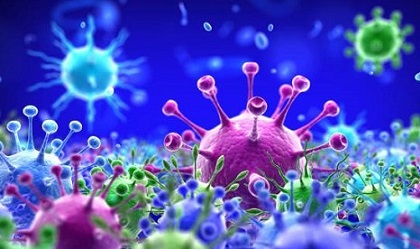WARNING! At The Rate The Omicron And XBB Sub-Lineages Are Evolving, Be Prepared For The Debut Of New Distinct SARS-CoV-2 Serotypes!
COVID-19 News - Debut Of New SARS-CoV-2 Serotypes Jun 07, 2023 2 years, 4 months, 3 weeks, 2 days, 17 hours, 16 minutes ago
Brace Yourself For The Emergence of New SARS-CoV-2 Serotypes Before The End Of 2023!
COVID-19 News: Since its discovery in late 2019, SARS-CoV-2, the virus causing COVID-19, has undergone a series of mutations, leading to the emergence of different viral variants. The rate of which it is evolving and spawning mutations is unprecedented in the history of virology. (I really wonder where are all those so called virology experts who in the beginning of the pandemic stated that the SARS-CoV-2 virus was not mutating and even if it did, it would become milder and simply die off!)
https://www.sciencemediacentre.org/expert-reaction-to-the-new-variant-of-sars-cov-2/
 Pic Credit: Inok-Istock/Getty
Pic Credit: Inok-Istock/Getty
These variants, such as the highly transmissible Omicron variant, have raised concerns about the possibility of distinct SARS-CoV-2 serotypes. With the continuous evolution of the Omicron and XBB sub-lineages, it is crucial to explore the implications of these changes and prepare for the potential debut of new serotypes.
The Omicron variant has attracted significant attention and
COVID-19 News coverages due to its ability to escape neutralizing antibodies induced by prior infections or vaccinations. As researchers delve deeper into the Omicron lineage, they have discovered nearly 3,000 different sub-lineages, including over 230 XBB sub-lineages now in existence!
Interestingly enough, as predicted, we are beginning to see anomalies in the Omicron and XBB evolutions including the omission of the ORF8 in some of the newer SARS-CoV-2 sub-lineages and now even the ORF 7 b proteins are undergoing frameshift alterations.
https://virological.org/t/repeated-loss-of-orf8-expression-in-circulating-sars-cov-2-lineages/931
According to one independent researcher who has been monitoring the evolution of the newer Omicron and recombinant variants and sub-lineages, there has been a ORF7b frameshift event in the Deltacron XBC.1 sub-lineage and also in the FR.1 sub-lineages (a B.2.75 derived sub-lineage).
https://twitter.com/LongDesertTrain/status/1666220307198140419
New proteins are even emerging on some of these SARS-CoV-2 sub-lineages, something never seen before. In one published study, a 3-nucleotide mutation in N, creating a new TRS-B, lead to the production of the N* protein, which has been shown to interfere with the immune response and increase viral loads, indicating the potential for significant changes in viral behavior.
https://www.nature.com/articles/s41467-022-28287-8
While many experts are stil
l stuck on the old school of thought when it comes to virology, be prepared that the SARS-CoV-2 still has lots of tricks up its sleeves and will throw in lots more of surprises that will challenge the current knowledge in the field of virology including things such as the interchangeability of the specific roles of the various NSP and ORF proteins and even the key roles played by certain so called “junk proteins” found on the genomic structure and the ability of the virus to code for miRNAs that play a role in immune suppression in the host.
Currently, scientists are primarily focused on investigating the possibility of distinct SARS-CoV-2 serotypes within the Omicron variant and its recombinant sub-lineages. Mutations in the S gene, as well as changes in non-structural proteins, may indirectly influence the emergence of these serotypes. Recombination events involving the S gene could also contribute to this phenomenon.
Continuous monitoring of SARS-CoV-2 variants is essential to identify the emergence of new viral serotypes promptly.
The emergence of distinct SARS-CoV-2 serotypes would have direct implications for vaccine formulations, immunodiagnostic platforms, and serological therapies.
Vaccine strategies might need to be adapted to account for the specific characteristics of each serotype. Rigorous serological studies involving well-characterized isolates and sera are necessary to validate the existence of different SARS-CoV-2 serotypes. However, the extensive number of variants makes investigating their antigenic profiles time-consuming.
The probability of distinct SARS-CoV-2 serotypes emerging over time remains a topic of debate. While the presence of background immunity from natural infection or vaccination may reduce viral replication and mutation rates, thus decreasing the likelihood of serotype emergence, adaptive immunity could also strengthen selection pressure and result in escape mutants. Mutations in non-structural proteins and recombination events further contribute to the complexity of viral evolution and the potential for serotype emergence. Reassortant events could also lead to a much faster debut of such new serotypes.
The ongoing evolution of the Omicron and XBB sub-lineages raises intriguing questions about the emergence of distinct SARS-CoV-2 serotypes. While investigations into the Omicron variant are currently at the forefront, it is essential to continue monitoring the possibility of other serotypes emerging. Insights gained from studying these phenomena will play a crucial role in shaping vaccine formulations, immunodiagnostic platforms, and serological therapies. By understanding the complex relationship between viral infection and immunity, we can better prepare for future outbreaks
For the latest
COVID-19 News, keep on logging to Thailand Medical News.
